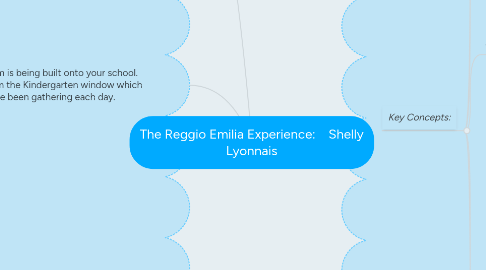
1. Activity: A new classroom is being built onto your school. The site can be seen from the Kindergarten window which is where the children have been gathering each day.
1.1. Materials:
1.1.1. -hard hats
1.1.2. -safety vests
1.1.3. -blocks, wood and large stones
1.1.4. -recycled materials (egg cartons, paper towel and toilet paper rolls, plastic bottles etc...)
1.1.5. -drawing materials
1.1.6. -blueprints of a buildings, pictures of construction sites/ blueprints for our school construction site if possible
1.1.7. -play trucks
1.1.8. -access to anything else in the classroom that the children would like to add
1.1.9. -examples of environmental print signs seen at a construction site (photographs from our own site and others)
1.1.10. -camera
1.1.11. -ask if parents involved in construction, engineering or architecht type positions would be willing to visit
1.2. Project:
1.2.1. -have the blueprints and pictures posted on a wall close to where the children will build. An adult can lead children in discussion about what the paper is and what the children think that they are looking at.
1.2.2. -children take the art materials to window where they can see the construction. The children can use clipboards or tape their paper to portions of the walls and windows. Children can sketch their own blueprints of our school site or sites of their own creation.
1.2.3. -use blueprints when creating with the blocks, recycleable materials and items chosen from around the room
1.2.4. -children can create their own environmental signs to warn visitors of the construction going on in the room
1.3. Documentation:
1.3.1. -make notes on conversations between children and between child and adult
1.3.2. -ask questions about the signs that the children are making, why are they important?
1.3.3. -ask students to explain blueprints that they created
1.3.4. -take pictures of the progress of the worksite both inside and outside for the children to compare and discuss
1.3.5. -children can explain to teachers, parents and visitors what they are doing, the stages that they went through and what is coming next
2. Reggio in Italy and North America
2.1. video
3. Key Concepts:
3.1. Historical Information:
3.1.1. -began in Reggio Emilia, Italy
3.1.2. -parents wanted exemplary early childhood education that reflected local beliefs and values
3.1.3. Loris Malaguzzi is a spokesperson that helped open the first municipal school in 1963
3.1.4. -philosophy built on social constructivist perspective, learning happens in social contexts
3.1.5. -run by board of directors with financial support from investors
3.1.6. -all money goes back into the school for improvements, research, professional development and collaboration with industrial partners
3.2. Educational Information:
3.2.1. -promotes critical thinking and collaboration
3.2.2. -not a prescribed curriculum
3.2.3. -a socially and culturally embedded philosophical approach
3.2.4. -democratic education, each child is a citizen and has rights
3.2.5. -environment promotes interaction, dialogue, reflection, collaborative inquiry and negotiated learning
3.2.6. -children and adults co-construct knowledge and understanding
3.2.7. -teachers reflect on and question content and methodology of practice to create democratic learning environments
3.2.8. -children from all socioeconomic and educational backgrounds are welcome
3.2.9. -hands on approach through experimentation
3.2.10. -no separation between theory and practice
3.3. Classroom/Curriculum Information:
3.3.1. -documentation of daily activities are chronicalled on the classroom walls
3.3.2. -activities are multi-sensory
3.3.3. -children have choice
3.3.4. -activities are collaborative to promote listening
3.3.5. -the children have unlimited time to explore, there are no artificial rotations to different centers or activities
3.3.6. -free play and informal learning activities
3.3.7. -curriculum centers on projects and investigations
3.3.8. -curriculum is child originated and teacher framed and supported
3.3.9. -art is integrated into the curriculum with the guidance of an in-house art specialist
3.3.10. -use of natural resources like clay, stone and wood etc, to build and create
3.3.11. -use of microscopes, computers, cameras etc to document and create
3.3.12. -classroom is made up of open spaces where everything can be seen which allows for choice between activities and fluid play between children
3.4. Assessment/Documentation Information:
3.4.1. -visual representations on the walls display pictures and student work
3.4.2. "visible learning", documentation collected through adult observation
3.4.3. -documentation of:
3.4.3.1. -learning strategies and processes
3.4.3.2. -encounters with materials
3.4.3.3. -interaction with peers and adults
3.4.3.4. -children questioning, thoughts and ideas
3.4.4. -documentation types:
3.4.4.1. -photographs
3.4.4.2. -samples of student work at different stages
3.4.4.3. -video observations
3.4.4.4. -transcriptions of discussions and explanations
3.4.4.5. -observation instead of standardized tests
3.4.5. -documentation occurs during and throughout activities
3.4.6. -teachers must be present but not intrusive, anticipate thinking and directions and negotiate understanding through dialogue
3.4.7. -a portfolio is created with student work and pictures
3.5. Parent Involvement:
3.5.1. -parents are highly valued
3.5.2. -share knowledge of children
3.5.3. -are welcome to participate in classroom activities
3.5.4. -are partners in information, implementation and documentation of projects
3.5.5. -research with teachers, ways to enhance learning
3.5.6. -co-responsibility in organization and design of the school and activities
3.5.7. -invited to stay at the center as long as needed for successful transition
3.5.8. -volunteers and active participants in building and creating projects and activities
3.5.9. -evening group meetings with teachers where concerns, interests, progress of students and patterns can be discussed
3.5.10. -ongoing conversations with teachers/no formal interviews

